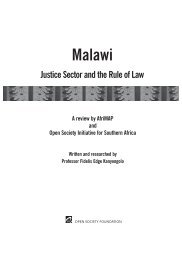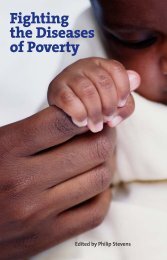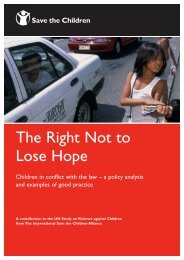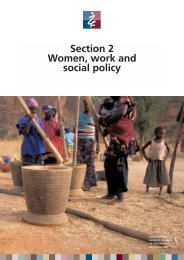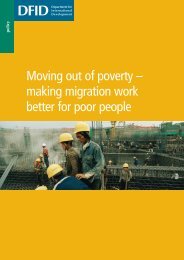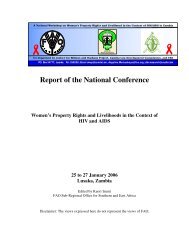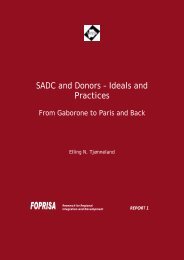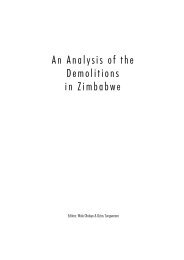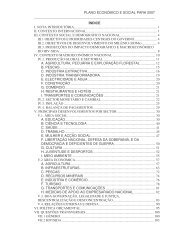The African Union Organs and the African Peer Review ... - SARPN
The African Union Organs and the African Peer Review ... - SARPN
The African Union Organs and the African Peer Review ... - SARPN
Create successful ePaper yourself
Turn your PDF publications into a flip-book with our unique Google optimized e-Paper software.
<strong>The</strong> <strong>African</strong> <strong>Union</strong> <strong>Organs</strong> <strong>and</strong> <strong>the</strong> <strong>African</strong> <strong>Peer</strong> <strong>Review</strong> Mechanism:Implications for Regional Integration in <strong>the</strong> Context of ContinentalStructuresBy Ayesha KajeeIntroductionMore than two years have elapsed since <strong>the</strong> birth of <strong>the</strong> new-look <strong>African</strong> <strong>Union</strong> (AU),during which time several of <strong>the</strong> major organs m<strong>and</strong>ated by <strong>the</strong> AU have come intoexistence, <strong>and</strong> various o<strong>the</strong>rs are due to be inaugurated in <strong>the</strong> near future. <strong>The</strong> AU alsoembraced as its developmental framework, <strong>the</strong> New Partnership for Africa’sDevelopment (NEPAD), launched in October 2001.While <strong>the</strong> ideal of a politically <strong>and</strong> economically integrated continent isn’t new, <strong>the</strong>energy created by <strong>the</strong> genesis of <strong>the</strong> AU <strong>and</strong> its organs has rekindled optimism for an<strong>African</strong> renaissance. Significantly, <strong>the</strong> voluntary <strong>African</strong> <strong>Peer</strong> <strong>Review</strong> Mechanism(APRM) has been introduced as a vehicle for improving governance st<strong>and</strong>ards <strong>and</strong>holding corrupt governments to account. <strong>The</strong> first four countries are to undergo reviewduring 2004.<strong>The</strong> past decade has also seen regional integration structures progress from <strong>the</strong>oreticaltalk-shops to practical implementation in many spheres. Institutions that were originallycreated primarily for economic reasons have exp<strong>and</strong>ed <strong>the</strong>ir scope to include political <strong>and</strong>security considerations (<strong>and</strong>, as in <strong>the</strong> case of SADC, vice versa).This paper briefly explores <strong>the</strong> relationship between regional structures such as SADC<strong>and</strong> <strong>the</strong> continental union, looking at how established regional organs <strong>and</strong> substructurescan dovetail (or not), with <strong>the</strong> corresponding continental ones, many of which are newlyformed. It seeks to determine <strong>the</strong> potential for synergy <strong>and</strong> complementarity between<strong>the</strong>se organs <strong>and</strong> to examine whe<strong>the</strong>r structures are being duplicated.Since <strong>the</strong> APRM is perhaps <strong>the</strong> single most innovative initiative of <strong>the</strong> AU, <strong>the</strong> paperattempts an analysis of <strong>the</strong> APRM as a tool that could have significant impacts onregional integration <strong>and</strong> regional development <strong>and</strong> explores <strong>the</strong> potential for regionalstructures such as SADC to become actively involved in <strong>the</strong> peer review process.Ultimately, <strong>the</strong> paper attempts to answer <strong>the</strong> question of whe<strong>the</strong>r <strong>the</strong> AU’s (<strong>and</strong>especially NEPAD’s) laudable but lofty aims can, in part, be operationalised via regionalbodies.Continental Integration: Marginalisation or Collective Power?Analysts offer various reasons for Africa’s socio-economic decline over <strong>the</strong> last fiftyyears, ranging from colonial legacies <strong>and</strong> globalisation to corrupt leadership <strong>and</strong> ongoingconflict. (Amuwo 2002; Chabal 2002; Taylor 2003).Notwithst<strong>and</strong>ing this, a key question is whe<strong>the</strong>r “continentalisation” in <strong>the</strong> envisaged AUcontext will fur<strong>the</strong>r marginalise already embattled poor regions <strong>and</strong> create regional
hegemonies, or whe<strong>the</strong>r it could be used (particularly via regional bodies) to givecollective bargaining power to previously voiceless states <strong>and</strong> regions?Proponents of pan-<strong>African</strong>ism point to <strong>the</strong> economic <strong>and</strong> political power wielded by <strong>the</strong>United States of America (USA) <strong>and</strong> <strong>the</strong> European <strong>Union</strong> (EU), <strong>and</strong> argue that <strong>African</strong>smust pool resources <strong>and</strong> act as a federation to make measurable impacts in <strong>the</strong> globalarena. Sustainable socio-economic development in any <strong>African</strong> state, <strong>the</strong>y contend,cannot occur in isolation, because Africa’s peoples have common colonial legacies <strong>and</strong>shared cultures in addition to contiguous borders.Already, united action by <strong>African</strong> states has resulted in some small victories, notably in<strong>the</strong> trade arena. <strong>The</strong> collective dispute action against first-world cotton subsidies by <strong>the</strong>West <strong>African</strong> cotton-producing states in <strong>the</strong> World Trade Organisation (WTO) is asignificant example of collective influence.Conversely, critics of <strong>African</strong> integration maintain that <strong>the</strong> net overall effect will beincreased marginalisation of <strong>the</strong> poorest countries <strong>and</strong> domination of poor states by thoseof <strong>the</strong>ir neighbours that have achieved some growth. This scenario could prolongconflicts currently plaguing <strong>the</strong> continent <strong>and</strong> could possibly foment increased violence.<strong>The</strong> penetration of various South <strong>African</strong> companies into o<strong>the</strong>r states in Africa is an oftcitedexample. At <strong>the</strong> NEPAD Agriculture Conference in December 2003, for example,<strong>the</strong>re were claims that South <strong>African</strong> supermarkets have had a negative impact on smallscalefarmers <strong>and</strong> small businesses in some countries. South <strong>African</strong> gem miningcompanies operating in Africa have also come under fire for failing to benefit <strong>the</strong> localpopulations since most of <strong>the</strong> beneficiation (cutting <strong>and</strong> polishing) is done outside <strong>the</strong>country where <strong>the</strong> gems are sourced. (Kajee <strong>and</strong> Gruzd, 2003:4)<strong>The</strong>re are also concerns in <strong>the</strong> agriculture <strong>and</strong> textiles sectors that trade liberalisationcould cause key sectors of certain <strong>African</strong> economies to collapse. <strong>The</strong>re has beensubstantial progress by regional economic communities (RECs) such as SADC towardsphased economic integration, with special provisos for sensitive commodities. RECs arefamiliar with regional concerns <strong>and</strong> have a critical role in maintaining <strong>the</strong>se phasedintegration frameworks <strong>and</strong> harmonizing <strong>the</strong>m with continental plans.<strong>The</strong> AU acknowledges this <strong>and</strong> seeks to ”co-ordinate <strong>and</strong> harmonize policies betweenexisting <strong>and</strong> future Regional Economic Communities for <strong>the</strong> gradual attainment of <strong>the</strong>objectives of <strong>the</strong> <strong>Union</strong>” (AU, 2002:Article 3, Objective l).However, significant practical barriers to integration exist, at both regional <strong>and</strong>continental levels. <strong>The</strong>se include <strong>the</strong> infrastructure gaps <strong>and</strong> lack of st<strong>and</strong>ardisation invarious sectors. For example, <strong>the</strong> establishment of regional <strong>and</strong> continental rail transportcorridors are stymied by <strong>the</strong> discrepancies in <strong>the</strong> gauge systems of Tanzania, Ug<strong>and</strong>a <strong>and</strong>Kenya (which are all built to 1000mm or metre gauge) <strong>and</strong> <strong>the</strong> rest of SADC countries,where <strong>the</strong>y are built to Cape gauge of 1067 mm.(SAIIA, 2003: 10). Limited transport <strong>and</strong>ICT infrastructure <strong>and</strong> poor maintenance of existing infrastructure are additional
impediments, some of which NEPAD has prioritised in its project plans. Politicalbarriers include onerous visa <strong>and</strong> customs controls that restrict <strong>the</strong> movement of labour<strong>and</strong> goods.Continental Political Structures <strong>and</strong> <strong>the</strong>ir Regional CounterpartsSignificant economic integration must occur in t<strong>and</strong>em with political integration. Indeed,integration is intrinsically a political process, predicated upon substantial political unity<strong>and</strong> <strong>the</strong> concomitant ceding of some sovereignty. <strong>The</strong> issue of sovereignty has been asensitive one in Africa, often impeding moves towards political convergence.<strong>The</strong> AU’s Constitutive Act of 2002 specifically m<strong>and</strong>ated <strong>the</strong> formation of nine separateorgans <strong>and</strong> provided for <strong>the</strong> establishment of o<strong>the</strong>rs at <strong>the</strong> discretion of <strong>the</strong> AU Assembly.Currently about 20 organs have been established, of which most are as yet looselydefined. <strong>The</strong>se include <strong>the</strong> AU Commission; <strong>the</strong> Pan <strong>African</strong> Parliament (PAP); <strong>the</strong>Peace <strong>and</strong> Security Council (PSC); <strong>the</strong> Court of Justice; <strong>the</strong> Court for Human <strong>and</strong>People’s Rights; <strong>and</strong> <strong>the</strong> Investment <strong>and</strong> Central Banks. <strong>The</strong>re are also various sectoralcommissions <strong>and</strong> committees.Various regional initiatives such as customs unions <strong>and</strong> free trade zones have long-rangeimplications for continental integration. While <strong>the</strong> AU is far from forming an integratedmonetary zone, for example, <strong>the</strong> long-term implications of <strong>the</strong> recent launch of acommon monetary area in West Africa, must be a factor for consideration by <strong>the</strong> AUBanks <strong>and</strong> o<strong>the</strong>r organs.Establishment of <strong>the</strong> various AU organs, <strong>and</strong> especially NEPAD’s APRM, signifies awillingness to relinquish some sovereignty in pursuit of <strong>the</strong> continental public good.However, <strong>the</strong> AU Commission (2004:4) notes that fostering political will to achieveintegration remains a major challenge <strong>and</strong> “requires that member states delegate power<strong>and</strong> progressively transfer sovereignty at both sub-regional <strong>and</strong> continental levels”.<strong>The</strong> AU structures often have regional counterparts with similar functions: <strong>the</strong> SADCParliamentary Forum <strong>and</strong> <strong>the</strong> East <strong>African</strong> Legislative Assembly may be regarded as <strong>the</strong>regional equivalents of <strong>the</strong> PAP, while <strong>the</strong> SADC Organ on Politics, Defence <strong>and</strong>Security (OPDS) is potentially <strong>the</strong> best-developed regional counterpart of <strong>the</strong> PSC.<strong>The</strong> challenge here is to align existing regional structures with continental ones, avoidingunnecessary duplication of bureaucracies <strong>and</strong> ensuring constant, unambiguouscommunication between <strong>the</strong>m.<strong>The</strong> regional structures <strong>and</strong> <strong>the</strong> AU both recognise this need for alignment. According toIsaksen (2002:46), <strong>the</strong> RECs “form building blocks for <strong>the</strong> future continental economiccommunity”. He notes that, in 2001, SADC Foreign Ministers acknowledged <strong>the</strong> linkagebetween NEPAD <strong>and</strong> SADC’s Regional Indicative Strategic Development Plan (RISDP).“…<strong>the</strong> RISDP <strong>and</strong> <strong>the</strong> SADC restructuring process should take NEPAD into account, <strong>and</strong>where appropriate, SADC <strong>and</strong> NEPAD programmes should be harmonised.” (Isaksen,2002:46). Similarly, <strong>the</strong> AU Commission aims to “ensure that <strong>the</strong> momentum ofcontinental integration is irreversible by promoting regional cooperation” via
“streng<strong>the</strong>ning of institutional linkages between <strong>the</strong> AU <strong>and</strong> <strong>the</strong> RECs” <strong>and</strong> “adoption ofcommon policies in specific areas” (AU Commission, 2004:15).While much has been written about economic integration, <strong>the</strong>re has been limitedconsideration of <strong>the</strong> structures <strong>and</strong> organs that will potentially facilitate politicalintegration. It <strong>the</strong>refore behoves us to examine some of <strong>the</strong>se.Parliamentary <strong>and</strong> Judicial Structures: Regional <strong>and</strong> Continental Implications<strong>The</strong> PAP, inaugurated in March 2004, is in its infancy. By contrast, <strong>the</strong> SADCParliamentary Forum <strong>and</strong> <strong>the</strong> East <strong>and</strong> West <strong>African</strong> Legislative Assemblies are longerestablished <strong>and</strong> may offer significant lessons.<strong>The</strong> newly established <strong>African</strong> Court for Human <strong>and</strong> Peoples’ Rights (ACHPR) <strong>and</strong> <strong>the</strong><strong>African</strong> Court of Justice, will face <strong>the</strong> challenges of upholding <strong>the</strong> rule of law <strong>and</strong>implementing justice on <strong>the</strong> continent. A key consideration is <strong>the</strong> divide between national<strong>and</strong> multinational legal <strong>and</strong> judicial systems. <strong>The</strong> bid to host <strong>the</strong> PAP in Libya, a countrywhose national government is not democratically elected, highlights <strong>the</strong> nature of thischallenge.Currently, members of <strong>the</strong> PAP are seconded by <strong>the</strong>ir national parliaments, in a similarmanner to <strong>the</strong> SADC PF, although <strong>the</strong>re are plans for <strong>the</strong> PAP to have some form ofelected representation in <strong>the</strong> future.In this event, <strong>the</strong>re may be value in seconding <strong>the</strong> same elected PAP MP to also serve in<strong>the</strong> relevant regional parliament, with a view to synchronizing regional policy withcontinental initiatives.<strong>The</strong> PAP presently operates in a purely advisory capacity. Political integration in <strong>the</strong>long-term will necessitate greater legislative power for <strong>the</strong> PAP <strong>and</strong> <strong>the</strong> regionallegislatures. In <strong>the</strong> past, member states have ignored <strong>the</strong> recommendations made byregional parliaments.Although <strong>the</strong> AU undertakes to “promote <strong>and</strong> protect human <strong>and</strong> peoples' rights inaccordance with <strong>the</strong> <strong>African</strong> Charter on Human <strong>and</strong> Peoples' Rights <strong>and</strong> o<strong>the</strong>r relevanthuman rights instruments” (AU, 2002: Objective 3) <strong>and</strong> has ratified various treaties <strong>and</strong>protocols on rights issues, corruption <strong>and</strong> democracy; <strong>the</strong> domestic legislation in manymember states deviates from <strong>the</strong> continental pledges. <strong>The</strong>re has been little attempt bynational parliaments to align domestic legislation with continental or internationalinstruments. Even in nations where domestic legislation corresponds with <strong>the</strong> continentalprotocols, failure to uphold <strong>the</strong> law is common. Often, military regimes or o<strong>the</strong>r forms ofstate-sanctioned repression hamper implementation of <strong>the</strong> law <strong>and</strong> abet miscarriage ofjustice.Until <strong>the</strong> power to enact <strong>and</strong> enforce legislation on issues that impact on all <strong>African</strong>s isceded to <strong>the</strong> PAP <strong>and</strong> o<strong>the</strong>r relevant bodies, abuse of basic human rights will continueunchecked in some areas. <strong>The</strong> differentiation of scope <strong>and</strong> focus between national,regional <strong>and</strong> continental legislatures is a crucial consideration <strong>and</strong> should be prioritised
y <strong>the</strong> PAP in its formative stages. Clarity regarding <strong>the</strong> limits of national sovereignty,<strong>and</strong> <strong>the</strong> precedence of regional <strong>and</strong> continental law, where appropriate, is necessary. <strong>The</strong>role <strong>and</strong> reach of supra-national judicial structures <strong>and</strong> of o<strong>the</strong>r monitoring <strong>and</strong>enforcement mechanisms should be elucidated.Ano<strong>the</strong>r tricky area where RECs can play a role is <strong>the</strong> incorporation of traditional legal<strong>and</strong> justice systems into <strong>the</strong> continental one. <strong>The</strong> potential value of traditional measureswas highlighted by Rw<strong>and</strong>a’s ‘gacaca’ system, which used <strong>the</strong> community-based “grasscourts” to bring justice to genocide victims in a situation where <strong>the</strong> formal system hadcollapsed (since most legal professionals were dead). Apart from alleviating pressure on<strong>the</strong> overcrowded prison system, regional reconciliation was enhanced as refugeesreturned from neighbouring countries <strong>and</strong> cross-border ties were resumed..Peace <strong>and</strong> Security Structures: <strong>The</strong> Relationship between <strong>the</strong> PSC <strong>and</strong> <strong>the</strong> SADCOrgan on Politics, Defence <strong>and</strong> SecurityDespite <strong>the</strong> ongoing restructuring within SADC, it is fair to say that <strong>the</strong> SADC OPDS hasmade some progress towards regional security integration, particularly in a strictlymilitary sense. Its Inter-State Defence <strong>and</strong> Security sub-Committee (ISDSC), whichdeals with military <strong>and</strong> intelligence cooperation, is staffed by defence officials frommember countries <strong>and</strong> has been a well-functioning body since <strong>the</strong> late 1990s.(Hammerstad, 2003: 149). Since <strong>the</strong> PSC will operate an <strong>African</strong> St<strong>and</strong>by Force whichwill essentially be operationalised through five sub-regional st<strong>and</strong>by brigades(Wannenberg <strong>and</strong> Kajee, 2003: 10), <strong>the</strong>re is considerable potential for synergy between<strong>the</strong> OPSD <strong>and</strong> <strong>the</strong> PSC, which should be exploited to prevent duplication. <strong>The</strong> OPDScould also contribute in an advisory capacity for PSC operations in o<strong>the</strong>r regions.Two crucial issues are: how to manage <strong>the</strong> relationship between <strong>the</strong> PSC <strong>and</strong> regionalstructures in a complementary manner ra<strong>the</strong>r than an antagonistic one so that resourcesare optimally used <strong>and</strong> can regional military brigades provide non-partisan intervention in<strong>the</strong> context of ethnic <strong>and</strong> political loyalties? <strong>The</strong>se questions are likely to remainunanswered until <strong>the</strong> PSC becomes operational <strong>and</strong> grapples with <strong>the</strong> realities ofpeacekeeping in Africa. <strong>The</strong> recent move by <strong>the</strong> AU to send peacekeepers to Darfur inSudan will provide a litmus test of <strong>the</strong> PSC’s efficacy.From a softer, human security viewpoint, <strong>the</strong> OPDS’s Inter-State Politics <strong>and</strong> Diplomacysub-Committee (ISPDC), is not yet fully operational <strong>and</strong> has significant overlaps witho<strong>the</strong>r directorates. As more human security-related issues come under <strong>the</strong> ISPDC’sauspices, it may also contribute value to o<strong>the</strong>r AU organs. <strong>The</strong> issue of refugees <strong>and</strong>displaced persons, for example, now falls under <strong>the</strong> ISPDC <strong>and</strong> may have relevance for<strong>the</strong> ACHPR <strong>and</strong> <strong>the</strong> Commission as well as <strong>the</strong> PSC. Hammerstad (2003:152)recommends that <strong>the</strong> ISPDC adopt a limited but high-priority human security agenda thatis manageable.While L<strong>and</strong>sberg (2002: 19) recognizes <strong>the</strong> synergies between SADC’s priorities <strong>and</strong>those of NEPAD <strong>and</strong> <strong>the</strong> AU in <strong>the</strong> peace <strong>and</strong> security sector, he identifies <strong>the</strong>harmonisation of priorities as <strong>the</strong> crucial challenge. He fur<strong>the</strong>r argues that <strong>the</strong> SADC
OPDS should play a key role in <strong>the</strong> APRM at regional level, since its two substructures -<strong>the</strong> ISDSC <strong>and</strong> <strong>the</strong> ISPDC - are “well-placed to adapt APRM to SADC conditions <strong>and</strong>dynamics”. (L<strong>and</strong>sberg, 2002: 20). Conversely, Hammerstad (2003: 152) views <strong>the</strong> PSC<strong>and</strong> APRM as potential obstacles to <strong>the</strong> OPSD, arguing that it is in danger of beingovershadowed by <strong>the</strong> AU initiatives.<strong>The</strong> <strong>African</strong> <strong>Peer</strong> <strong>Review</strong> Mechanism: Implications for Regional BodiesIn March 2003, a small group of <strong>African</strong> leaders made a groundbreaking decision when<strong>the</strong>y agreed to “open <strong>the</strong>ir books” <strong>and</strong> allow <strong>the</strong>ir governments to be scrutinised by <strong>the</strong>irpeers via <strong>the</strong> APRM. Since <strong>the</strong>n, a total of twenty three countries have acceded to peerreview, <strong>and</strong> several o<strong>the</strong>rs have indicated that <strong>the</strong>y will join <strong>the</strong> APRM in <strong>the</strong> near future.In contrast with <strong>the</strong> old Organisation of <strong>African</strong> Unity (OAU) which prioritised statesovereignty <strong>and</strong> allowed for very little intervention in <strong>the</strong> governance of member states,<strong>the</strong> AU’s Constitutive Act made specific provisions for intervention in member states forsecurity purposes (Article 5) <strong>and</strong> provided for sanctions against any “member state thatfails to comply with <strong>the</strong> decisions <strong>and</strong> policies of <strong>the</strong> <strong>Union</strong>.” (AU 2002, Article 23).At <strong>the</strong> time, this was seen as a positive move away from blind respect for sovereigntytowards a situation where <strong>the</strong> union would intervene in countries that disregardeduniversal principles of good governance <strong>and</strong> democracy. <strong>The</strong> APRM was expected to be<strong>the</strong> mechanism through which <strong>the</strong> AU would be given “teeth” to act in such situations.However, <strong>the</strong> decision to make <strong>the</strong> APRM a voluntary mechanism without explicitpenalties or sanctions is widely regarded to have considerably weakened <strong>the</strong> initiative.Fur<strong>the</strong>rmore, late in 2002, conflicting statements from <strong>the</strong> South <strong>African</strong> presidency <strong>and</strong>foreign affairs ministry seemed to indicate that <strong>the</strong> APRM would focus on economicgovernance <strong>and</strong> leave <strong>the</strong> political governance, democracy <strong>and</strong> human rights issues to <strong>the</strong><strong>African</strong> <strong>Union</strong>, were viewed by many as an attempt to appease those <strong>African</strong> leaders whowould be inclined to reject APRM on <strong>the</strong> basis of <strong>the</strong>ir poor records in <strong>the</strong> democracy <strong>and</strong>human rights arenas. Such a move that would have significantly diluted <strong>the</strong> scope <strong>and</strong>impact of peer review, since political governance affects <strong>the</strong> economic climate <strong>and</strong> viceversa. In <strong>the</strong> face of widespread criticism, a statement that APRM would incorporatepolitical governance (with <strong>the</strong> proviso that this aspect of APRM would be carried out byrelevant AU organs such as <strong>the</strong> ACHPR <strong>and</strong> PAP as soon as <strong>the</strong>y were operationalised),subsequently clarified <strong>the</strong> issue. Accountability for aspects of peer review such as humanrights <strong>and</strong> elections has thus been shifted from NEPAD to AU organs that are in <strong>the</strong>irinfancy <strong>and</strong> are currently perceived as lacking <strong>the</strong> power to effect changes in <strong>the</strong>se areas.Poor governance in one nation-state inevitably impacts on its neighbours, with majoreconomic <strong>and</strong> political consequences for <strong>the</strong> region. In recent years, this has been amplyillustrated by <strong>the</strong> regional impact of <strong>the</strong> Zimbabwe crisis in Sou<strong>the</strong>rn Africa (Isaksen,2002: 29–32) <strong>and</strong> <strong>the</strong> Liberian <strong>and</strong> Ivorian ones in West Africa. Regional destabilisation<strong>and</strong> insecurity, decreased regional investment <strong>and</strong> cross-border migration are indirecteffects of governance abuse in one or more countries. It thus behoves regional structuresto become actively involved in <strong>the</strong> APRM, supporting <strong>the</strong> review process where possible
<strong>and</strong> using it as a tool to drive <strong>the</strong> development agenda of <strong>the</strong> RECs. Indeed, SADC’sRegional Indicative Strategic Development Plan (RISDP), formally launched in March 2004,specifically embraces NEPAD as a credible <strong>and</strong> relevant continental framework <strong>and</strong> positions <strong>the</strong>RISDP as <strong>the</strong> vehicle for achieving NEPAD’s aims within SADC member states. <strong>Peer</strong> review ispotentially <strong>the</strong> single NEPAD initiative that could accelerate regional development throughcompliance. REC’s <strong>and</strong> <strong>the</strong>ir organs can leverage <strong>the</strong>ir knowledge <strong>and</strong> constituency base to play<strong>and</strong> important role in this regard..APRM Structures <strong>and</strong> Organisation<strong>The</strong> heads of state of <strong>the</strong> APRM countries comprise <strong>the</strong> APR Forum, <strong>the</strong> highest-levelstructure at <strong>the</strong> continental level, which is where <strong>the</strong> actual “peer pressure” willultimately be exerted. <strong>The</strong> APR Forum has appointed a panel of seven eminent persons –<strong>African</strong>s of high stature <strong>and</strong> integrity from <strong>the</strong> various regions of <strong>the</strong> continent – taskedwith overseeing <strong>the</strong> process <strong>and</strong> ensuring its credibility. Ms Marie Angelique Savane ofSenegal is <strong>the</strong> current chairperson of <strong>the</strong> panel. <strong>The</strong> continental APRM Secretariat inSouth Africa is responsible for coordination <strong>and</strong> implementation of <strong>the</strong> review process.At <strong>the</strong> national level, each APRM country must establish an APRM focal point(preferably at ministerial level or higher), to facilitate access to <strong>the</strong> head of state <strong>and</strong>relevant ministries that will participate in <strong>the</strong> review. (APR Forum 2004: 6). Asrecommended by <strong>the</strong> eminent persons to <strong>the</strong> APR Forum, <strong>the</strong> country must also set up anational coordinating mechanism, including all <strong>the</strong> key government <strong>and</strong> civil societystakeholders that should be part of <strong>the</strong> review. (APR Forum 2004: 6). <strong>The</strong> exact nature of<strong>the</strong> national focal points <strong>and</strong> coordinating mechanism varies from one country to ano<strong>the</strong>r,depending on each country’s resources <strong>and</strong> geo-political makeup. Ghana, for example,has a dedicated Ministry for Nepad, via which <strong>the</strong>se structures are established. Kenya, on<strong>the</strong> o<strong>the</strong>r h<strong>and</strong>, established a semi-autonomous national Nepad Secretariat, which iscurrently setting up <strong>the</strong> APR structures.Regional structures have been slow to grasp <strong>the</strong> opportunities offered by involvement inNEPAD <strong>and</strong> peer review. Both NEPAD <strong>and</strong> APRM have been widely perceived asinitiatives driven by executive levels of government, with little or no formal involvementof parliaments <strong>and</strong> government departments (World Bank Institute, 2004). Since manyregional organs are resourced via secondments from government departments <strong>and</strong> <strong>the</strong>legislatures of <strong>the</strong> member states, ownership of NEPAD initiatives at regional level hasbeen weak. East <strong>African</strong> countries took <strong>the</strong> lead last year, when <strong>the</strong>y m<strong>and</strong>ated <strong>the</strong> KenyaNEPAD Secretariat to serve as <strong>the</strong> Regional Secretariat for East Africa.As several sou<strong>the</strong>rn <strong>African</strong> countries have agreed to be peer reviewed, <strong>and</strong> o<strong>the</strong>rs haveindicated that <strong>the</strong>y are considering participation, SADC could play a valuablecoordinating role at <strong>the</strong> regional level. Several committees <strong>and</strong> structures that alreadyexist within SADC <strong>and</strong> o<strong>the</strong>r RECs could feed valuable information into <strong>the</strong> four coreareas of <strong>the</strong> APRM (political governance <strong>and</strong> democracy, economic governance,corporate governance <strong>and</strong> socio-economic development). Since APRM has been widelymooted as an all–<strong>African</strong> initiative, it is envisaged that peer review will be fundedprimarily via a contribution of $100,000 from each country that accedes to beingreviewed, but thus far several countries have failed to meet this obligation due to resource
constraints. Fur<strong>the</strong>rmore, various analysts have estimated that this figure will beinsufficient to adequately assess <strong>the</strong> governance situation in <strong>the</strong> depth that is specified by<strong>the</strong> APRM documents, with Herbert (2003:10) suggesting that a proper analysis wouldrequire this amount to be quadrupled.According to L<strong>and</strong>sberg (2002: 20) “one way of enhancing <strong>the</strong> (peer review) mechanismwould be to devolve it down to <strong>the</strong> regional level. Thus <strong>the</strong> SADC should play a role in<strong>the</strong> peer review process, <strong>and</strong> its political <strong>and</strong> diplomatic structures in particular shouldplay a key role.” As yet, no institutional links exist. In areas where SADC has existingcapacity, it could share human <strong>and</strong> technical resources with <strong>the</strong> APR, perhaps evenoffering some staff as members of <strong>the</strong> review teams <strong>and</strong> providing an infrastructural nodefrom where review team for countries in <strong>the</strong> region could operate. Utilizing existingcapacity within <strong>the</strong> RECs for APRM could significantly decrease <strong>the</strong> financial constraintson <strong>the</strong> peer review process.<strong>The</strong> <strong>Review</strong> Process – What role for Regional Structures?<strong>The</strong> APRM comprises five phases. In <strong>the</strong> initial step, <strong>the</strong> country to be reviewedestablishes its APR Focal Point <strong>and</strong> National Mechanism, completes a self-assessmentquestionnaire <strong>and</strong> develops a draft plan of action. In parallel with this, <strong>the</strong> continentalAPRM secretariat (with <strong>the</strong> help of various partner institutions) collects backgrounddocumentation on <strong>the</strong> country <strong>and</strong> identifies <strong>the</strong> major governance challenges facing <strong>the</strong>country, compiling a “Big Issues Paper”. If fur<strong>the</strong>r in-depth analysis is required, <strong>the</strong>secretariat will undertake technical assessments on <strong>the</strong>se big issues.<strong>The</strong> second phase is <strong>the</strong> country review visit, where a review team, headed by one of <strong>the</strong>eminent persons <strong>and</strong> including experts in each of <strong>the</strong> four areas of peer review, visits <strong>the</strong>country <strong>and</strong> conducts a series of interviews <strong>and</strong> investigations in order to assess <strong>the</strong>governance climate within <strong>the</strong> country.Next, <strong>the</strong> team compiles its country report <strong>and</strong> shares this with <strong>the</strong> government of <strong>the</strong>review country. Significantly, <strong>the</strong> government cannot change or edit <strong>the</strong> report, but itscomments are attached as an appendix to <strong>the</strong> report.Fourth, <strong>the</strong> eminent persons review <strong>the</strong> report <strong>and</strong> make recommendations to <strong>the</strong> APRForum. Fellow leaders in <strong>the</strong> Forum discuss with <strong>the</strong> head of <strong>the</strong> review country how <strong>the</strong>ycan support <strong>the</strong> review country to implement its action plan in <strong>the</strong> period until <strong>the</strong> nextreview.Lastly, <strong>the</strong> report is made public <strong>and</strong> is tabled in various AU structures such as <strong>the</strong> Pan<strong>African</strong> Parliament.As mentioned, Regional bodies have <strong>the</strong> potential to make meaningful contributions atvarious phases in <strong>the</strong> process. Reports <strong>and</strong> surveys undertaken by <strong>the</strong> RECs in a reviewcountry or region should be submitted as background documentation to <strong>the</strong> continentalsecretariat (SADC election observer missions, trade integration reports, etcetera).Regional structures can offer technical expertise, where relevant, to <strong>the</strong> review country as
it undertakes its self-assessment, <strong>and</strong> to <strong>the</strong> APR Secretariat if technical analyses areconducted.For countries where <strong>the</strong> political or economic situation has widespread regional effects,organs of <strong>the</strong> RECs can highlight areas of concern by making formal written <strong>and</strong> oralsubmissions to <strong>the</strong> APR Secretariat, to <strong>the</strong> eminent persons <strong>and</strong> to <strong>the</strong> country reviewteam at various stages in <strong>the</strong> review process. In <strong>the</strong> case of SADC, for example, <strong>the</strong>parliamentary forum’s St<strong>and</strong>ing Committee on Regional Integration could make asubmission on <strong>the</strong> bureaucratic or legal barriers in <strong>the</strong> review country that hamper intraregionaltrade <strong>and</strong> discourage investment. Similarly, <strong>the</strong> Gender Advisory Team <strong>and</strong>Election Observer Missions can provide in-depth <strong>and</strong> up-to-date knowledge of <strong>the</strong>country’s situation regarding gender rights <strong>and</strong> <strong>the</strong> freedom <strong>and</strong> fairness of electionsrespectively.<strong>The</strong> regional structures can play a crucial role in maintaining <strong>the</strong> integrity of <strong>the</strong> APRM,as <strong>the</strong>y can focus attention on areas of concern that <strong>the</strong> review country might o<strong>the</strong>rwisebe inclined to conceal. In addition, regional structures can be key players in ensuring that<strong>the</strong> recommendations emanating from <strong>the</strong> review are indeed being implemented in <strong>the</strong>inter-review phase. <strong>The</strong> issues that are likely to emerge from peer review, such ascurbing corruption in all sectors <strong>and</strong> improving delivery of basic services, are already on<strong>the</strong> agenda of many regional organs. <strong>The</strong> RECs can use <strong>the</strong> peer review as a catalyst forchange in <strong>the</strong>se spheres, <strong>the</strong>reby accelerating regional development. However, <strong>the</strong> latest(2004) SADC Summit in Mauritius did issue new guidelines on free elections but did notprovide links with <strong>the</strong> APRM.Using Regional Bodies to Implement Continental Plans: PotentialAdvantages <strong>and</strong> Limitations<strong>The</strong> advantages are clear: regional bodies have <strong>the</strong> opportunity to mobilise resourcesfrom <strong>the</strong> continent <strong>and</strong> use <strong>the</strong>se to drive <strong>the</strong> regional development agenda <strong>and</strong> topromote stability <strong>and</strong> investment in <strong>the</strong> region. But <strong>the</strong> disadvantages are also manifest:<strong>the</strong> potential for unnecessary <strong>and</strong> inefficient duplication of structures <strong>and</strong> bureaucracies ishuge. <strong>The</strong> AU needs to carefully audit existing regional structures, assessing <strong>the</strong>irorganisational capacity <strong>and</strong> efficiency levels, before incorporating <strong>the</strong>m as feedermechanisms for <strong>the</strong> continental organs. This presupposes additional resourcing wherenecessary <strong>and</strong> streamlining in cases of inefficient resource use.Management <strong>and</strong> communication are key issues in realising <strong>the</strong> AU Commission’s vision(2004: 8) that RECS will transform into comprehensive Regional IntegrationCommunities (RICs), responsible for political, social <strong>and</strong> economic integration atregional level. RECs will eventually “evolve from intergovernmental organisations to aConfederation <strong>and</strong> later, Federation” (AU Commission, 2004:15). Poor communicationis already evident within <strong>the</strong> continental NEPAD <strong>and</strong> APRM secretariats, with extremedifficulty encountered during recent efforts to access basic information. Managers of AUorgans need to acknowledge <strong>the</strong> shortcomings regarding communication <strong>and</strong> takeconcerted action to rectify this.
According to <strong>the</strong> AU Commission (2004:16) “Regional institutions will play anincreasingly vital role in <strong>the</strong> debate on (harmonizing) regional policies”, particularlymacro-economic policies <strong>and</strong> social programmes. Indeed, <strong>the</strong> commission anticipates <strong>the</strong>emergence of regional <strong>and</strong> continental citizenships as a result. Whe<strong>the</strong>r this vision can berealised depends largely on <strong>the</strong> degree of citizen ownership of regional <strong>and</strong> continentalinitiatives, in particular <strong>the</strong> <strong>African</strong> <strong>Peer</strong> <strong>Review</strong> Mechanism.While it is regrettable that responsibility for <strong>the</strong> political aspects of peer review have beenh<strong>and</strong>ed to AU institutions (eg. <strong>The</strong> PAP) that are relatively new <strong>and</strong> perceived as beingineffectual for <strong>the</strong> time being, this opens up space for longer–lived REC organs to play ameaningful role in <strong>the</strong> APRM <strong>and</strong> to use this to accelerate regional integration initiatives.While peer review per se does not aim at enhancing integration, increased regionalintegration could be a significant offshoot of <strong>the</strong> APRM process. Regional bodies haveunprecedented opportunities to develop mutually advantageous relationships withcontinental ones, as <strong>the</strong> various continental organs <strong>and</strong> mechanisms come on-line. Amissed opportunity could mean that <strong>the</strong> regional structures wi<strong>the</strong>r in <strong>the</strong> shadow of <strong>the</strong>continental imperatives, which are perceived as more “glamorous” <strong>and</strong> are thus oftenbetter resourced. On <strong>the</strong> o<strong>the</strong>r h<strong>and</strong>, an opportunity grasped may be <strong>the</strong> conduit fordevelopmental progress in a given sphere of activity within <strong>the</strong> region, <strong>and</strong> may channelhuman, technical <strong>and</strong> financial resources to <strong>the</strong> region that could simultaneouslyaccelerate regional integration plans such as SADC’s RISDP.
BibliographyAPR Forum. 2004. Communique Issued at <strong>the</strong> End of <strong>the</strong> First Summit of <strong>the</strong>Committee of Participating Heads of State <strong>and</strong> Government in <strong>the</strong> <strong>African</strong> <strong>Peer</strong><strong>Review</strong> Mechanism (APR Forum). Kigali, Rw<strong>and</strong>a, 13 February 2004.AU Commission, 2004. Strategic Framework of <strong>the</strong> <strong>African</strong> <strong>Union</strong> Commission.2004-2007 (Final Draft). 4 March 2004. Addis Ababa: <strong>African</strong> <strong>Union</strong>.AU, 2002. Constitutive Act of <strong>the</strong> <strong>African</strong> <strong>Union</strong>. Addis Ababa: <strong>African</strong> <strong>Union</strong>Amuwo, K. 2002. “Globalisation, Nepad <strong>and</strong> <strong>the</strong> Governance Question in Africa.”Gainesville: <strong>African</strong> Studies Quarterly 6(3) Online Journal:[http://web.africa.ufl.edu/asq/v6/v6i3a4.htm]Chabal, Patrick 2002. “<strong>The</strong> quest for good government <strong>and</strong> development in Africa:is NEPAD <strong>the</strong> answer?” International Affairs: 78(3) 447-462. London.Cilliers, J. 2003. Peace <strong>and</strong> Security through Good Governance? A guide to <strong>the</strong>NEPAD <strong>African</strong> <strong>Peer</strong> <strong>Review</strong> Mechanism. ISS Paper no. 70. Pretoria: Institute forSecurity StudiesHammerstad, A. 2003. “A Long Road to SADC Security Intervention: Is <strong>the</strong> Organon Politics, Defence <strong>and</strong> Security Heading in <strong>the</strong> Right Direction?” In: Hansohm,D., Breytenbach, W. <strong>and</strong> Hartzenberg, T. (eds). 2003. Monitoring RegionalIntegration in Sou<strong>the</strong>rn Africa Yearbook Vol 3. Windhoek: Gamsberg Macmillan.Herbert, R. 2003.‘Becoming my bro<strong>the</strong>r’s keeper’. In: eAfrica: <strong>The</strong> ElectronicJournal of Governance <strong>and</strong> Innovation. Vol1: October 2003. Johannesburg: SAIIA,Isaksen, J. 2002. Restructuring SADC – Progress <strong>and</strong> Problems. R 2002:15. Bergen:Chr. Michelsen Institute.Kajee, A. <strong>and</strong> Gruzd, S. 2003. “More Jobs from Gems”. In eAfrica: <strong>The</strong> ElectronicJournal of Governance <strong>and</strong> Innovation. Vol 1: July 2003: pp 4-5. Johannesburg: SAInstitute of International Affairs.L<strong>and</strong>serg, C. 2002. “Building a regional society in Sou<strong>the</strong>rn Africa: <strong>The</strong>Institutional Governance Dimension.” Policy: Issues <strong>and</strong> Actors (15:1).Johannesburg: Centre for Policy StudiesMair, S. 2001. “EAC, ECOWAS <strong>and</strong> SADC: An Inter-Regional Comparison” In:Hansohm, D., Peters-Berries, C., Breytenbach, W. <strong>and</strong> Meyns, P. (eds). 2001.Monitoring Regional Integration in Sou<strong>the</strong>rn Africa Yearbook Vol 1. Windhoek:Gamsberg Macmillan.Melber, H. 2003. South Africa <strong>and</strong> Nepad – Quo Vadis? South <strong>African</strong> RegionalPoverty Network (<strong>SARPN</strong>):Online report[http://www.sarpn.org.za/documents/d0000682/index.php]NEPAD Secretariat, 2001. <strong>The</strong> New Partnership for Africa’s Development(NEPAD). Johannesburg: NEPAD. (An updated version is available online at
[http://www.dfa.gov.za/au.nepad/nepad.pdf]SADC, 2001. Treaty of <strong>the</strong> Sou<strong>the</strong>rn <strong>African</strong> Development Community (Amended).Gaborone: SADC Secretariat.SADC, 2003. Regional Indicative Strategic Development Plan (RISDP) for <strong>the</strong>Sou<strong>the</strong>rn <strong>African</strong> Development Community. Gaborone: SADC Secretariat.SAIIA 2003. “A Question of Gauge.” In: SADC Barometer Issue 3: pp10.Johannesburg: South <strong>African</strong> Institute of International Affairs.Taylor, Ian 2003. “Globalization <strong>and</strong> regionalization in Africa: reactions toattempts at neo-liberal regionalism.” <strong>Review</strong> of International Political Economy:10(2) 310-330.Wannenberg, G. <strong>and</strong> Kajee, A. 2003. “<strong>African</strong> Peacekeeping: A M<strong>and</strong>ate WithoutMoney?”. In eAfrica: <strong>The</strong> Electronic Journal of Governance <strong>and</strong> Innovation. Vol 1:June 2003: pp 10-11. Johannesburg: SA Institute of International Affairs.World Bank Institute 2004. “APRM <strong>and</strong> Parliaments” - Videoconference for SADCParliamentarians. 6-7 May 2004. Cape Town, Dar-es-Salaam <strong>and</strong> Washington DC.




